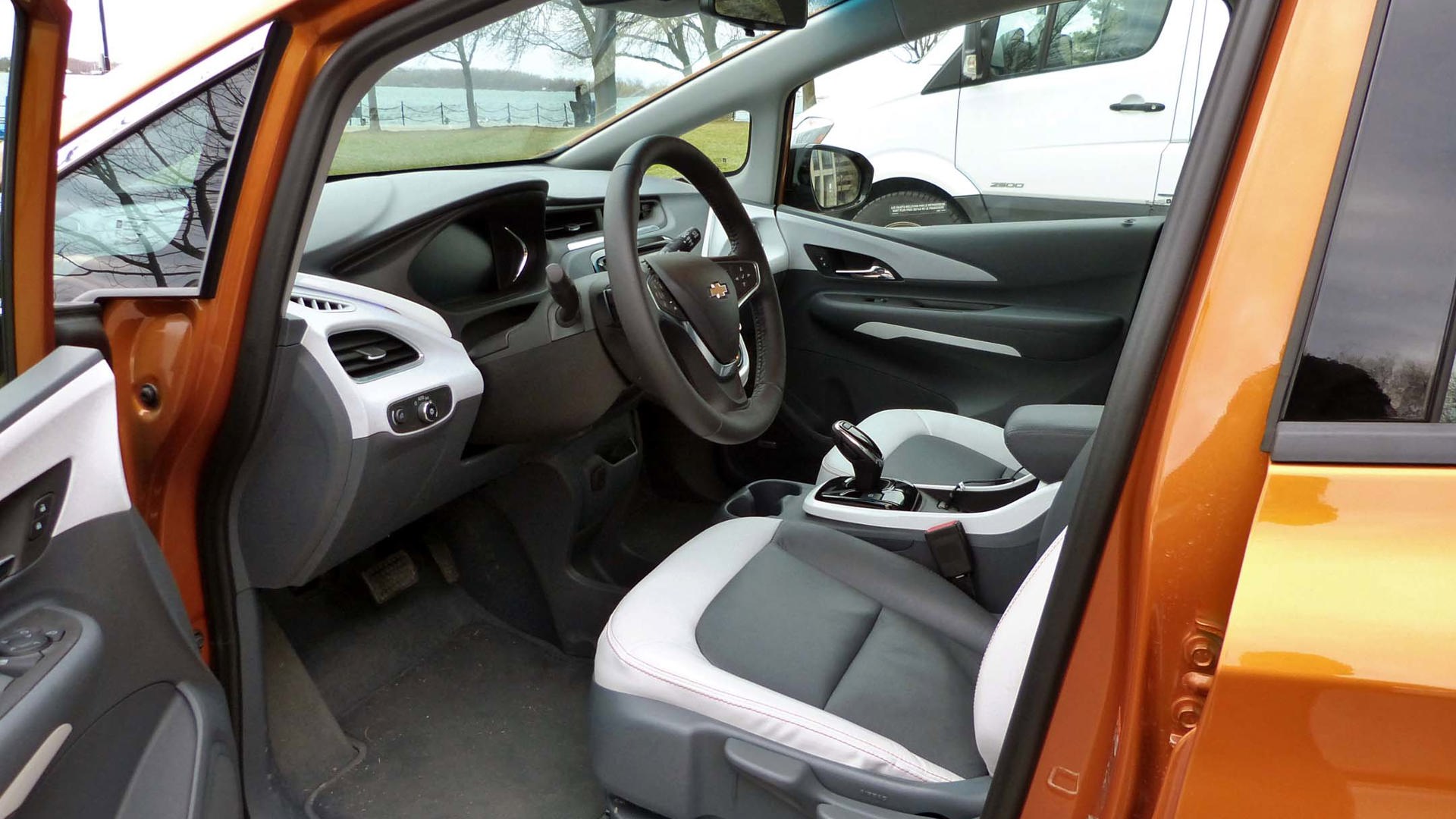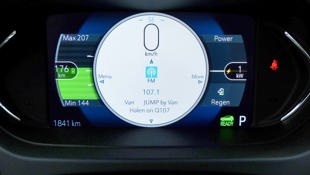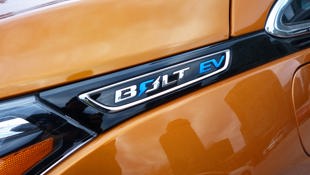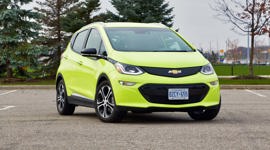 AutoTrader SCORE
AutoTrader SCORE
-
STYLING7/10
-
Safety6/10
-
PRACTICALITY6/10
-
USER-FRIENDLINESS9/10
-
FEATURES8/10
-
POWER8/10
-
COMFORT7/10
-
DRIVING FEEL7/10
-
FUEL ECONOMY9/10
-
VALUE5/10
While the multitudes were waiting in the rain to throw their hard-earned $1,000 at a future Tesla Model 3 late last year, Chevrolet was quietly unwrapping its own 300-plus km electric vehicle for the masses: the 2017 Chevrolet Bolt EV.
Chevrolet’s Bolt then, is more than just a solid little runabout, it’s a properly fun little car.
This is the car many say is the Model 3’s biggest threat. A mainstream EV with strong range that is already on the market, long before the cult-icon Model 3 had even been given its first on-road test.
With not even a household outlet in my condo building garage and no charging station available at work, I had been nervous to test EVs in the past. But this one had enough juice (theoretically) to get me to and from work all week, and there is a charging station near work that I could use. Range anxiety then, shouldn’t be an issue.
I like the look of it too. Burnt orange (or in GM-speak “Orange Burst Metallic”) is a fetching colour on any car, and the Bolt is interesting without being balls-out bonkers. It looks at once like a futuristic EV and like any other car on the road. Nice effort.
But at $51,130 as-tested, the Bolt isn’t exactly a no-brainer.
The 200 hp and 266 lb-ft of torque available in the 1,624 kg Bolt is enough to shame many a hot hatch, and the little Chevy is one of the fleetest of foot I’ve driven in recent times. Stabbing the accelerator is a humorous exercise in almost all situations, though you’d want to be careful not to chirp the front tires in front of a police officer. They consider that poor manners and react harshly – even if it is an instant-torque-generated accident.
Chevrolet’s Bolt then, is more than just a solid little runabout, it’s a properly fun little car. The handling isn’t bad either. The chassis is nimble and responsive and while the steering is over-boosted, there’s enough butt-talk in the seat for that not to tarnish things too much. One wonders, given that electric motors need little in terms of packaging and cooling, if a rear-mounted, rear-wheel-drive version wouldn’t be more fun.
One-foot driving is possible courtesy of a regenerative braking paddle on the steering wheel, which slows the car to a complete halt. I was surprised by this, as my memory from the Volt launch said it would only slow you to around three km/h, but I repeatedly stopped dead using the paddle alone. Fun times!
The interior is spacious and airy, with plenty of leg, shoulder and head room for all players. Those of us with a sugar-rich diet might find the seats a tad narrow. Surprising, given this is a North American car.
The dashboard is the typical GM fare. A vibrant, colourful and pretty MyLink-based unit complete with Android Auto/Apple CarPlay and of course, gamified energy screens to help you manage your battery and also improve your green-cred driving habits. I enjoyed the massive digital display behind the wheel and its wealth of information as well as the funky illuminated dashboard upon start-up and shutdown.
But I was far less enamoured with the camera-based rear-view mirror.
The camera system is a neat concept, but let down by execution. Because the screen doesn’t extend all the way to the edge of the mirror you’re left with a reflective surface around the rear-view screen. This is distracting and disconcerting. Otherwise, the extra-wide rearward view is a great thing. Chevy needs to either put a black plastic border around the mirror or find a way to expand the screen all the way to the edges. I ended up pulling the tab and reverting to normal old mirror mode.
Driving around in temps of between –2 and 5 degrees for the week, I made good use of the heated steering wheel and seat without having to dip too often into the range-chewing climate control. When I did need to turn on the window defogger, range plummeted from 185 km minimum to 165 – or about 10 percent. That’s significant given that we live in Earth’s freezer.
Which brings me to charging. Underneath the two false floors you’ll find a cable which you can connect to any regular 120 volt household outlet – in my case, one in a deep, dark corner of our underground parking garage that nobody noticed me plugging into. The other end goes in the car. Voila! Charging at work!
Then I looked up the charging rates: 6.5 km/hr on that plug. Which means my 38 km round-trip commute would take six hours to replenish during the work day – more than enough time for day-to-day.
But if I wanted to fully charge the car and only had a household outlet? From empty, that would take some 50 hours. Go on a 300 km round trip on Saturday and you still won’t be fully charged come Monday morning.
So the Bolt (like all gas-free EVs) only makes sense if you fork out the $2,000 to install a Level 2 charger, about $1,000 for the unit and another $1,000 for installation. This is offset in Ontario and Quebec with a $1,000 government rebate. That will get you a full charge – good for an EPA-estimated 383 km – in around 9.5 hours.
The other downside? How many phone charging cables have you had to buy over your lifetime because you lost one? With the charge cable being big, bulky and a pain to pack away I guarantee there’ll be a few that get left behind or go missing. That’s problematic, and another reason most Bolt owners will simply use a charging station.
Level 2 equipment is what’s found at most public charging stations as well. And there was about a kilometre away from work, but I felt like leaving my car there and walking to work was onerous, and also rude given that I'd then be blocking a charging station for longer than needed.
On longer trips – over 150 km each way – you’ll want to map out the locations of “Level 3” DC fast chargers, which will provide about 144 km of range (roughly 40 percent charge) in 30 minutes.
A handy mobile app will help you monitor the charge rate and status of your Bolt, but it (like the onboard Wi-Fi connection) requires an active OnStar subscription to operate.
Other gripes are minor: The interior panel gaps are bigger than I’d like (there’s a big discrepancy in the height of the door trim compared to the dash) and there’s no available sunroof.
When push comes to shove, the Bolt is a great car but it fits a slim niche. This is a totally valid way to market a car, and I applaud General Motors for putting out something that moves the whole industry forward the way Bolt does. The Bolt’s biggest problem is its own older brother, the confusingly similar-sounding Chevrolet Volt.
That particular banana does all the same things the Bolt does and still allows you to go on a longer, petrol-powered drive should the mood strike you – and it’s $4,000 cheaper. Both are eligible for the $5,000 (BC), $8,000 (Quebec) or $14,000 (Ontario) provincial rebates that bring the price of both down substantially in those provinces, whether you lease or buy.
If you want to throw your money behind the future of technology: buy the Bolt.
But if you want to have your cake and eat it too, the Volt is a better bet.
| Engine Displacement | 150 kW electric motor |
|---|---|
| Engine Cylinders | N/A |
| Peak Horsepower | 200 hp |
| Peak Torque | 266 lb-ft |
| Fuel Economy | 1.21 Gigwatts |
| Cargo Space | 480 L |
| Model Tested | 2017 Chevrolet Bolt EV Premier |
| Base Price | $47,795 |
| A/C Tax | $100 |
| Destination Fee | $1,600 |
| Price as Tested | $51,130 |
|
Optional Equipment
$1,635 – Driver Confidence Package $575; Infotainment Package $565; Orange Burst Metallic $495
|
|














































